|
|
Welcome to Google map of County Donegal |
Video's about Donegal. |
| |
| . |
|||||||
|
|||||||
|
|
| Donegal has large areas of mountains and infertile land, however the valleys of the Foyle and Finn in the east have fertile soils. Farmers in the east and north grow barley, oats, and potatoes as their main crops. The main type of farming is cattle-rearing, with sheep-rearing in upland areas. Some farmers are involved in dairying and the raising of pigs and poultry. Most farms are less than 30 hectares (74 acres) in size. The larger ones are in the east. The west of the county the holdings are tiny and the land very infertile, making it totally impossible to to make a living from them. Manufacturing industry are not as important as
in previous Nearly half of the people of Donegal work in service industries, including retailing, defense, education, health, public administration, transport and tourism, income from the latter has increased significantly in recent years due in no small way to the efforts of Board Fàilte.
|
||
|
|
| There
ere are two hydroelectric power stations on the River Erne in the south,
About 25% of the Republic's catch of sea fish is landed, Killybegs being the principal port. Other fishing ports include Burtonport, Downings, Greencastle, Moville, and Rathmullen. Herring and mackerel fishing are especially important at Killybegs. The town of Killybegs has a fish meal plant which processes offal from all over Ireland, in recent years Russian factory ships landed some of their catch in the town, and a thriving service industry has grown up in the town. The county is well provided for regarding road transport, the national primary roads N13 and N15 in the east and south of the connect Letterkenny and Lifford with Derry and Sligo. The west of the county is served by the N56. Donegal lost all its railways in the spate of closures in the 1950's and 60's.. |
||
|
|
| Donegal
is described with some justification During the Ice Age the land was sculpted by the vast sheets of ice, rounding the mountain tops and carving out valleys, these glaciers carried their spoil along and deposited them in the lowland areas of southeast, forming the drumlins that are to be seen over much of Ulster. The county can boast the highest sea cliffs in Ireland or Britain rising 600 (1960 Ft) meters from the Atlantic Ocean. The coastline also has many secluded beaches with not a soul to be seen. In the north the coast is deeply indented, where the Inishowen Peninsula separates the long inlets of Lough Swilly and Lough Foyle. Malin Head, the most northerly point in Ireland, is on this coast. Among the many offshore islands on the west coast are those of Arranmore and Tory. |
||
|
|
Google
Map of County Donegal. |
||
| |
||
|
|
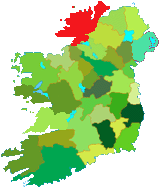
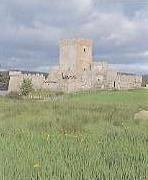 county has
a Gaeltacht area, a part of Ireland in which people use the Irish
language in everyday life, this extends over a wide area in west
Donegal and has a population of about 26,000. Elsewhere in the county
English is the everyday language. Donegal has much folklore, and
some traditional features of life survive, many country pubs have
regular
county has
a Gaeltacht area, a part of Ireland in which people use the Irish
language in everyday life, this extends over a wide area in west
Donegal and has a population of about 26,000. Elsewhere in the county
English is the everyday language. Donegal has much folklore, and
some traditional features of life survive, many country pubs have
regular 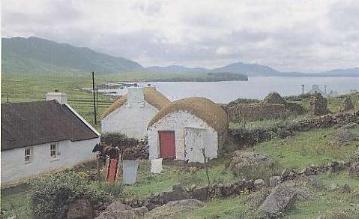 times. The decline of the textile industry in Europe effected Donegal
badly where nearly half the people of Donegal worked in the textile and
clothing industries, and these have traditionally been the major areas
of economic activity. Donegal is famous for handmade tweed and knitwear.
Other industries include fish and other food processing.
times. The decline of the textile industry in Europe effected Donegal
badly where nearly half the people of Donegal worked in the textile and
clothing industries, and these have traditionally been the major areas
of economic activity. Donegal is famous for handmade tweed and knitwear.
Other industries include fish and other food processing. 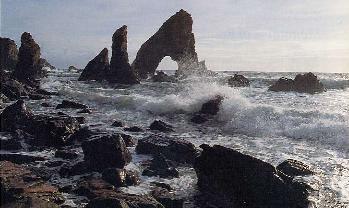 and a
small one is on the River Clady in the west. Nearby at Gweedore is a small
peat-fired plant.
and a
small one is on the River Clady in the west. Nearby at Gweedore is a small
peat-fired plant. 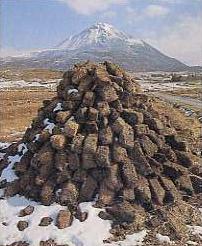 as rugged, the deeply indented coast, he wild moors and mountains bestow
on Donegal a grandeur and beauty that once seen in never forgotten. The
highest mountain in the county is Errigal (Pictured right) which rises
to 752 meters (2467 Ft) it consists largely of the hard mineral quartzite,
granite is also to be found in considerable quantities in the county.
as rugged, the deeply indented coast, he wild moors and mountains bestow
on Donegal a grandeur and beauty that once seen in never forgotten. The
highest mountain in the county is Errigal (Pictured right) which rises
to 752 meters (2467 Ft) it consists largely of the hard mineral quartzite,
granite is also to be found in considerable quantities in the county.